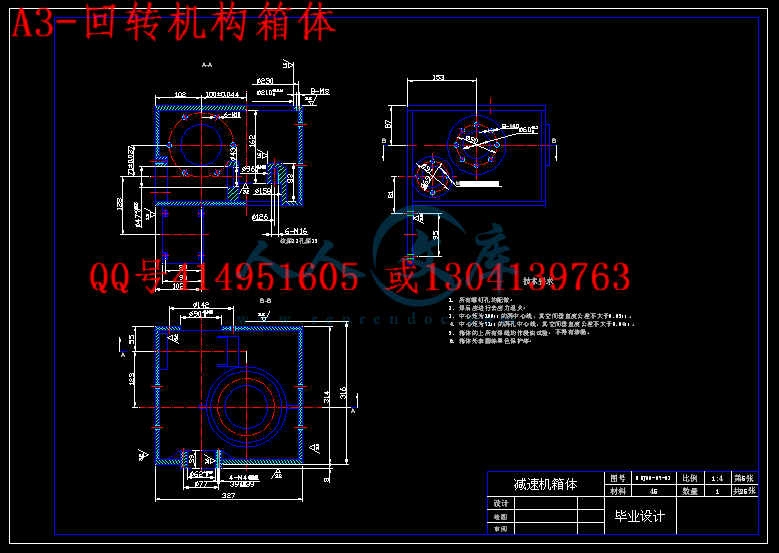【温馨提示】 购买原稿文件请充值后自助下载。
[全部文件] 那张截图中的文件为本资料所有内容,下载后即可获得。
预览截图请勿抄袭,原稿文件完整清晰,无水印,可编辑。
有疑问可以咨询QQ:414951605或1304139763
文档包括:
说明书一份,60页,25000字左右.
任务书一份.
翻译一份.
PPT答辩稿一份.
图纸共25张:
A0-总装配图.dwg
A0-回转机构.dwg
A1-机架.dwg
A3-回转机构箱体.dwg
A3-扇形齿轮.dwg
A4-传递齿轮.dwg
A4-传递齿轮轴.dwg
A4-第二级蜗杆.dwg
A4-第二级蜗轮.dwg
A4-第二级蜗轮轴.dwg
A4-第一级蜗杆.dwg
A4-第一级蜗轮.dwg
A4-工作台.dwg
A4-倾斜轴.dwg
A4-小齿轮.dwg
A4-小齿轮轴.dwg
A4-轴承盖.dwg
A4-轴承盖1.dwg
A4-轴承盖2.dwg
A4-轴承盖3.dwg
A4-轴承座1.dwg
A4-轴承座2.dwg
A4-轴套1.dwg
A4-轴套2.dwg
A4-左转轴.dwg
题 目 0.1t普通座式焊接变位机
1、本论文的目的、意义 焊接变位机是将工件回转、倾斜,以便使工件上的焊缝至于水平和船形位置的机械装置,主要用于机架、机座、机壳等非长形工件的焊接。
座式焊接变位机是应用最广的一种焊接变位机,载重量一般为1~50吨,本设计主要进行0.1t的普通座式焊接变位机的设计,该装备是以电动机—减速机驱动工作台回转并倾斜的焊接变位机械,是适应相关工件焊接需要而出现的焊接设备。
2、学生应完成的任务:
(1) 设计图纸A0当量大于3张;
(2) 设计说明书一份;
(3) 英文翻译一份;
(4) 设计日志一份
摘 要
焊接变位机是一种焊接辅助设备,它与焊接操作机、焊接滚轮架并称为焊接辅助设备中三大机。焊接变位机是应焊接行业的机械化、自动化发展需要而产生的。焊接变位机作为一种焊接配套设备,用于管子横向对接焊接,管子与法兰内外环缝焊接,管子对管子全位置焊接。焊接变位机可水平翻转角度,通过工作台的回转及翻转运动使工件上焊缝处于最理想的位置进行焊接,从而大大提高焊缝质量,减轻焊工劳动强度,尤其是适合焊接各种轴类、盘类、筒体等回转工件的理想设备。
本设计分析了解国内外焊接变位机的发展状况、以及焊接变位机在焊接机器人中的应用,设计了一种0.1吨小型座式焊接变位机。该变位机具有两个自由度,有两套独立的驱动和传动装置。可以方便实现工件的旋转和倾斜翻转,从而能使焊缝变化到平焊位置或“船形”位置。文中对驱动力的计算、机架的设计进行了说明,尤其是对传动装置的设计进行了重点说明。
本焊接变位机采用直流电机—减速机驱动工作台回转并倾斜,具有运动精度高、惯量小、制动性和稳定性好,可实现无级调速,方便实现正反转等优点。批量生产可获得比较高的经济效益。
关键词: 焊接变位机; 变位自由度; 焊接辅机; 焊接自动化设备;
Abstract
Welding positioner is a kind of welding auxiliary equipment, it was known as the three planes in welding auxiliary equipment with welding manipulator, welding roller bed. Welding positioner was designed with the development of welding industry mechanization, and automation. As a welding auxiliary machine, welding positioner was used in pipe′s landscape orientation welding, pipe and flange′s inside and outside central linking welding, pipe welding in all location. Though the gyration and retroflexion of the workbench, the welding positioner can make the welding line to an ideal position, which can improve the quality of the welded joint, reduce welder’s workload. It is ideal equipment especially fit to weld the kinds of workpiece, just like the shaft, tray, canister, and so on.
By understanding the welding positioner′ s development in domestic and overseas, and the positioner used in welding robot is described in the paper. A small block 0.1 ton s of welding positioner is designed. The positioner has two freedoms of motions and two unattached formula driving device and gearing. It can easily achieve the gyration and the inclination of the workpiece, thereby changing welding seam to downhand position or “ship form” position. the count of driving power is calculated, the framework of the welding positioner is designed, especially the gearing.
This welding positioner used DC motor and slowdown plane to drive the workbench to gyration or inclination. It has some advantages, such as a high-precision movement, inertia small, good braking and stability. It also can easily achieve stepless speed regulation, positive or negative turns. Because of its notables economic benefit, if it would been produced largely.
Key words: welding positioner,freedom of deflection,welding auxiliary machine, welding automatic equipment.
目录
第一章 绪论 1
1.1 设计焊接变位机的意义 1
1.2 国内外焊接变位机发展简介 1
1.3 我国焊接辅助设备简介 3
1.3.1 我国焊接辅助设备的发展历程 3
1.3.2 焊接辅助设备的发展趋势 4
1.4 关于焊接机器人 5
1.4.1 国内焊接机器人技术的发展 5
1.4.2 我国焊接机器人的应用状况 5
1.4.3 应用焊接机器人的意义 6
1.4.4 我国焊接机器人应用工程 7
1.4.5 焊接机器人的最新应用技术 8
1.5 关于焊接变位机的几个基本定义 9
1.5.1 焊接变位机的定义 9
1.5.2 主自由度及全功能焊接变位机 9
1.5.3 焊接变位机的变位自由度 10
1.5.4 变位机的第一主参数 -- 额定负荷 10
1.6 焊接变位机的分类 11
1.6.1 焊件变位机的类型 11
1.6.2 焊机变位机械的类型 13
1.6.3 焊工变位机的类型 14
1.7 几种常见的焊件变位机的类型及特点 14
1.8 设计本焊接变位机的目的和意义 16
第2章 总体设计 17
2.1 本焊接变位机总体设计及适用范围 17
2.2 设计方案的确定 17
第3章 传动部分设计 21
3.1 传动部分的总体设计要求 21
3.2 传动系统的分析和拟定 21
3.3 本焊接变位机传动系统的确定 23
3.3.1工作台回转系统 23
3.3.2 工作台倾斜系统 23
3.4 电动机的选择 24
3.4.1 电动机类型的选择 24
3.4.2 电动机功率的确定 27
3.4.3电动机转速的验证 33
3.5 传动比的拟定及确定 34
3.5.1 总传动比的确定 34
3.5.2 各级传动装置传动比的分配 34
3.5.3.计算传动装置的运动和动力参数 36
3.6 蜗轮、蜗杆的选择及校核 38
3.6.1 蜗杆传动的特点 38
3.6.2 蜗杆头数和蜗轮齿数的选择 39
3.6.3 蜗杆传动的强度计算 40
3.7 齿轮的设计与校核 42
3.7.1 工作台倾斜机构中的齿轮的设计与校核 42
3.8 谐波齿轮减速器的选择 44
3.9 轴的设计与校核 47
3.9.1 轴的结构设计原则 47
3.9.2轴的初估 47
3.9.3 轴的强度校核 48
3.10 轴承的选择与校核 52
3.10.1 轴承的选择 52
3.10.2 轴承的校核 52
第4章 机架的设计 55
4.1 机架的设计 55
4.2 机架焊接结构设计 56
4.2.1 机架应用焊接结构存在的问题 56
4.2.2 焊接结构的设计措施 57
结论 58
致 谢 59
参考文献 60







 川公网安备: 51019002004831号
川公网安备: 51019002004831号